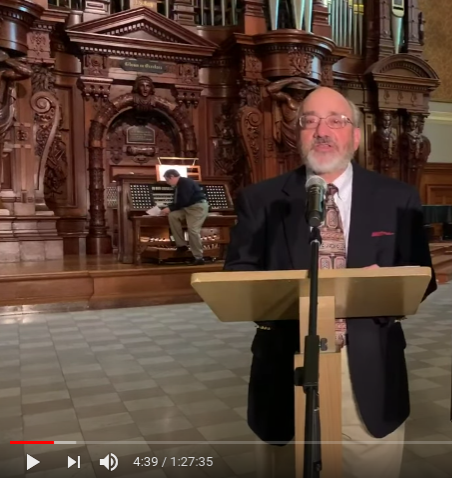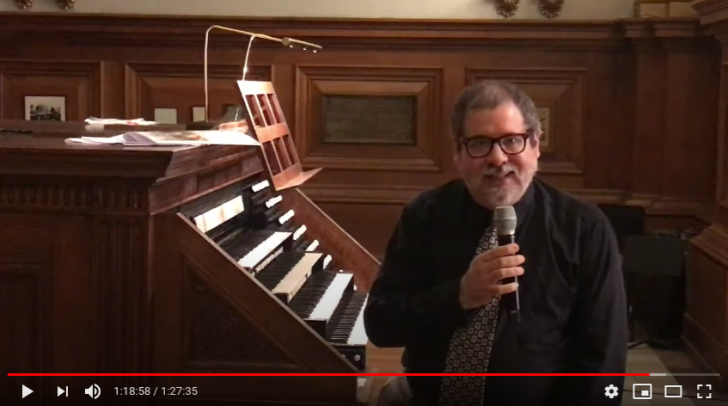For more than a century the Methuen Memorial Music Hall (MMMH) in Methuen, Massachusetts has been making music inside its walls. And inside those walls is something of storied splendor: a world class organ, fondly referred to as “The Great Organ,” that began its trans-Atlantic journey from the Netherlands on New Year’s Day, 1863. It has been delivering much of MMMH’s music for many decades with few interruptions. These unprecedented times have generally not stopped that music making, either, and earlier this month the eighth program of the 2020 Wednesday Night Summer Recital Series (until August 26), another organ recital was performed in this grand hall by organist, teacher and composer Leonardo Ciampa.

But the seats were empty then. Instead, the music was streamed live and now at the new MMMH YouTube channel along with other recitals and concerts. The MMMH channel, though relatively new, will undoubtedly soon become a valuable resource not only for local music lovers, but thousands of grateful viewers. Nonetheless, the reality that a gifted musician gracing a magnificent instrument in an acoustically splendid, historic auditorium performed to completely empty seats is a hard truth to face, and almost antithetical to one of the great pastimes of human culture. For a performance has, really, four critical participants: the auditorium, the performer, the audience, and an inexplicable energy, a “feedback loop” if you prefer, that’s created by the interplay among those first three. Perhaps the most critical is the audience—and though they were missing from the Music Hall, Ciampa played for them anyway. It was clear that he wasn’t treating this as a recording session, but rather transmuting to us through the camera lens.
Still, there are some advantages to witnessing an organ recital by video, and the production here was superb. One such advantage is being able to see, up close, the organist’s great act of music-making choreography. One moment in particular stands out in “Cantilena (Song),” the second of Fabio Pietro di Tullio’s lovely “Three Pieces.” Here (at about the one hour mark of the video), you see Ciampa playing on four separate keyboards simultaneously—his right hand stretched between two of them, his left hand on a third, one foot on the pedal board, another manipulating a decrescendo pedal, creating a wonderfully inventive mix of registers. This is something one would never see from a seat in the auditorium, but only hear in wonder. Another advantage comes, again, with artistic videography, where visual and aural elements can mix for a magical experience—as in the moment of the 23:18 mark during the third section of Girolamo Frescobaldi’s “Bergamasca” (from his extraordinary and important set of organ works “Fiori Musicali” (Musical Flowers)-1635). Here, after a bright fugue and other scholarly counterpoints, the music changes dramatically. We experience this moment from about 6 feet behind Ciampa seated at the helm of this magnificent beast of an organ—we see in detail the deep red mahogany carvings of figures of strength, some in repose, and violins that grace either side of the console, with intricate, magnificently carved filigree all around. And as we make out the gilded words just above Ciampa’s head, “Gloria in Excelsis,” Frescobaldi’s music enters into a serene and mysterious wandering. It’s a moment of surprising musical and visual reward.

And, of course, there’s the advantage of a clean, clear acoustical rendering of a recital that, without argument, is the result of decades of love and labor on the recitalist’s part. Live performances with other concertgoers always gives chance to noisy mishaps. None of those mishaps had chance to happen here, and Ciampa did not fail to deliver a delightful, well considered concert, and one can hear in this kind of format all the exceptional details of his superb playing.
In a concert packed with little surprises and enchantments, several moments stand out for purely musical reasons. The inclusion of Padre Davide da Bergamo (1791-1863) is indeed welcome, especially for the captivating work that Ciampa features by him, his “Elevazione in D minor” (composition date unknown). Da Bergamo was a prolific composer, busy monk, and great organist. His work is meant for a moment in the Catholic Mass when the sacramental host has been blessed and then held up high for all to adore with humility and reflection. But instead of creating music of prayerful meditation for this, Da Bergamo gives us essentially a recitative and aria suited for opera, complete with full throttle organ power and all stops out. It’s a wonderful moment of over-the-top Romantic music that is little known in the concert hall. Much credit should be given to Ciampa for featuring newer composers along with the old, and one such work that was a very welcome selection was Pietro Yon’s “Adagio (Andante Religioso)” which he transcribed for solo organ from his “Concerto Gregoriano” of 1920. Yon was an Italian who spent most of his life in America, becoming the organist at St. Patrick’s Cathedral in New York City, and who contributed some real gems to the repertoire. This Adagio is one of those gems—a moving work, where an ethereal middle section is bookended by a weighted ostinato in the pedals that evoke the deliberate, measured steps of pilgrimage. Lastly was Ciampa’s own “Fantasia montanara (Variations on ‘Quel mazzolin di fiori’)” which he wrote in this year (2020). It’s a lovely piece, a set of variations based on an old Italian folk song that was popular with Italian soldiers in World War I, including Ciampa’s grandfather (and the work is, fittingly, dedicated to his grandparents). It’s a testament to the theme-and-variations genre, with inventive derivations and delightful register work and ending with hearty majesty.

Two additional and intriguing aspects stand out in this recital: first is Ciampa’s choice of works to perform, and secondly, the general quietude and discoveries that characterize them. Regarding the selection, all pieces on the program were written by Italian composers, including Ciampa himself, who is a third-generation Italian-American. And it’s a markedly thoughtful selection. By selecting all Italian composers, we are educated with a history of that country’s influence on Western organ music (and on music in general). Hearing older works by Da Bergamo, Petrali, and Bossi leads to delightful discoveries (most of us have heard works by Scarlatti and Frescobaldi, certainly, but their works as Italian composers certainly deserve their place in this recital). And hearing the new, modern works by Amici, di Tullio, Yon, and Ciampa offers even more unexpected delights—it’s heartening to know that composers are still writing solid music for the organ, clearly a heritage that dates back centuries, as shown in this recital.
Regarding the tenor of the recital, it’s fascinating that with all the might that “The Great Organ” can produce, Ciampa chose works, instead, that mainly explore the organ’s riches of sonorities. In each piece, Leonardo Ciampa played with the touch of a man in love with his instrument, celebrating its extraordinary powers for meditative beauty rather than focusing on its earth-rattling bombast. Deftly performed with soulfulness and care, it was a Thinking Man’s recital, and refreshingly so.
